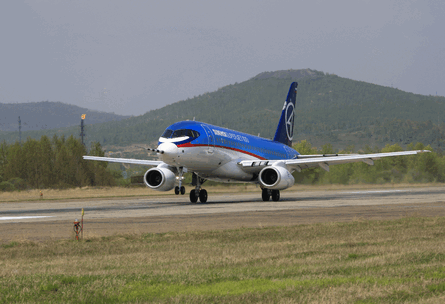Russia's efforts to reinvigorate its civil aerospace industry by restructuring it around the Sukhoi-dominated United Aircraft (OAK) and modernising its manufacturing technology are far-reaching. But if the country's 2008 performance in delivering airliners is any indication, there is a long way to go before its industrial output begins to match its ambitions.
Last year, the Russian aviation industry delivered just seven mainline airliners - just half of a Kremlin target of only 14 units. None of the three heritage manufacturers - Antonov, Ilyushin and Tupolev - lived up to promises and the newcomer Sukhoi Civil Aircraft, with its Uzbeki partner TAPO, also disappointed.
Russia's airframers were, to be fair, not spared the fourth-quarter hammering dished out by a global financial crisis that affected their rivals in Europe and the Americas. In the last quarter, leading Russian banks that provide 80% of the country's aerospace credit lines effectively suspended funding for the industry. Interest rates (in the national currency) proved prohibitive, rising from 6-10% before the crisis to 14-20% by late 2008.
But deliveries were limited to seven Tupolev Tu-204s: three Tu-204-100s to Red Wings, two Tu-204-300s to Vladivostok Avia, a single Tu-204-120CE to Air China Cargo (ordered in 2001 and delivered three years behind schedule) and a single Tu-214 (Tu-204-200) to Transaero.
Several completed aircraft remained at three main plants - four Ilyushin Il-96s at Voronezh ASO, three Tu-204s at Aviastar-SP in Ulyanovsk and two Tu-214s at Kazan APO.
WORK IN PROGRESS
At the end of 2008 VASO had three Il-96-400T freighters, effectively "white tails" since Aeroflot Cargo refused to accept them. Reports of the first being delivered proved premature, as in acceptance trials the aircraft fell 200km (110nm) short of the design target of a 5,000km range with full payload of 92t. In turn, Ilyushin Finance says it is cautious about the financial stability of Aeroflot Cargo, an independent subsidiary that has struggled to raise funds for aircraft acquisitions.
 |
|---|
One Il-96-300, for GTK Rossiya's presidential air detachment, was undergoing tests that should have been complete by year-end.
Aviastar-SP had three airframes completed but not delivered to customers because Russian banks were unwilling to provide the balance of funding due. Cubana de Aviacion did not take a Tu-204-100CE freighter, rebuffing attempts by Russia's VneshTorgBank to charge it a higher interest rate than the agreed 7-8%, a figure that had been approved by the Russian and Cuban governments.
Another Tu-204 freighter, destined for Volga-Dnepr, remained at the plant due to similar funding problems. The third airframe, a Tu-204-100V for Red Wings, was near completion at year-end.
Samara-based Aviacor was to have delivered four Antonov An-140s last year, but completed none. The Kazan APO plant did not complete manufacturer trials on a special mission Tu-214 for a government agency. Another special mission airframe was in the final stages of work at year-end.
Looking forward, market demand for Tupolev twin-engined narrowbodies remains firm but that for Ilyushin widebody quads looks soft given Aeroflot Cargo's refusal of the Il-96-400Ts.
VASO's future is the Antonov An-148 regional jet, with plans for annual production of 24 complete aircraft and another 12 kits to be assembled by Ukraine's KiGAZ Aviant plant. Roll-out of the first VASO-assembled An-148-100 has slipped from December 2008 to March-April this year, to be followed by "short" manufacturer trials to test considerable changes from the Antonov-built prototypes and delivery to GTK Rossiya, which has a firm order for six, plus six options.
 |
|---|
© Sukhoi |
Flight testing of the Sukhoi Superjet 100 regional jet has proceeded slower than expected, with problems with its PowerJet SaM146 turbofans cited as the biggest headache. The timing of the first delivery is uncertain, although Sukhoi pledges to start this year. Aeroflot, which expected its first SSJ in November and a second in December 2008, and then another 28 at a rate of one a month, is renegotiating terms. Armenian Airlines, with orders for two aircraft, may become the first to operate an SSJ on revenue services.
Source: Flight International



















